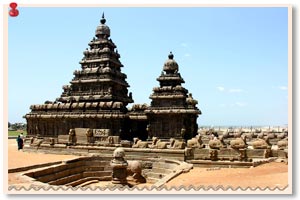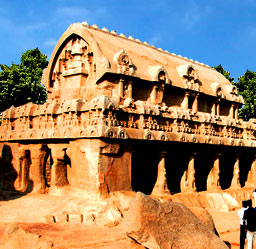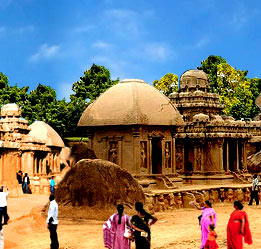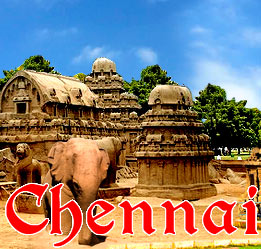 There are many stories related to the origin of its name. Some say that, it has been named after the demon King Mahabali, who was famous for his kindness and on the other hand, others believe that it has been named after the King Narasimhavarman I of the Pallava dynasty, who was a great warrior and that his name was kept because his achievements. Whatever may have been the origin, one thing is for certain – Mahabalipuram is one of the most visited tourist destinations in Tamil Nadu. And together with Chennai and Kanchipuram, it forms 'Golden Tourism Triangle' on the shore of Coromandel Coast. This 7th century port city of the Pallavas, which was a dynasty of Dravidian civilization, includes several historical monuments which were mainly structured in that era.
There are many stories related to the origin of its name. Some say that, it has been named after the demon King Mahabali, who was famous for his kindness and on the other hand, others believe that it has been named after the King Narasimhavarman I of the Pallava dynasty, who was a great warrior and that his name was kept because his achievements. Whatever may have been the origin, one thing is for certain – Mahabalipuram is one of the most visited tourist destinations in Tamil Nadu. And together with Chennai and Kanchipuram, it forms 'Golden Tourism Triangle' on the shore of Coromandel Coast. This 7th century port city of the Pallavas, which was a dynasty of Dravidian civilization, includes several historical monuments which were mainly structured in that era.This tourist destination has been listed amongst the UNESCO World Heritage Site because of its importance and ancientness of the sculptures and temples which depict its historical past and traditional legacy and also about the Dravidian civilization. The major attraction of Mahabalipuram is the Shore temple which is devoted to Lord Shiva and Lord Vishnu, sited on the Bay of Bengal with the gateway from the Western side away from the sea. It is one of the world heritage sites and also one of the ancient rock cut temples in the country. Noted for its complex carvings embellished with beautiful motifs and craftsmanship, the architectural designs of this temple are absolutely fascinating.
However, there are many other temples and statuettes which are magnificent in their carvings, one of which is Thirukadalmallai, the temple devoted to Lord Vishnu which was constructed by the King of Pallava dynasty to protect the sculptures from the waves coming from the sea. It is said that after the construction of this temple, the sculptures were able to withstand the turbulent waves of the sea and have been preserved since then. But the place is most renowned for Arjuna's Penance, which is a relief statue on a huge scale representing an episode from the Hindu epic, the Mahabharata; and the Varaha Cave, which is a small rock-cut temple built during the 7th century. Plus, there are Pancha Rathas (Five Chariots) which comprise of five colossal pyramidal constructions named after the Pandavas: Yudhistra, Bhima, Arjun, Nakul and Sahdeva together with their wife Draupadi. All the five chariots are built from granite carved in a unique style. These monuments and sculptures are delicate examples of the architectural pattern of the Pallava dynasty.
Apart from the monuments and temples, there are Mandapas which were built during the Pallava dynasty. These Mandapas are very beautifully carved and are adorned with spell-bounding motifs. The biggest Mandapam is dedicated to Lord Krishna and the sculptures inside it marvellously portray the brave legends of Lord Krishna. Besides this, there is Mahishasuramardini Mandapam, which is a rock cut temple depicting the war between the Goddess Durga and the demon Mahishasura, who changed himself into a buffalo. This Mandapa is the finest example of the architectural designs of the Pallava dynasty; the carvings and the designs are simply splendid and breathtaking. The Ganesh Mandapam is another shrine which is visited everyday by the people.





